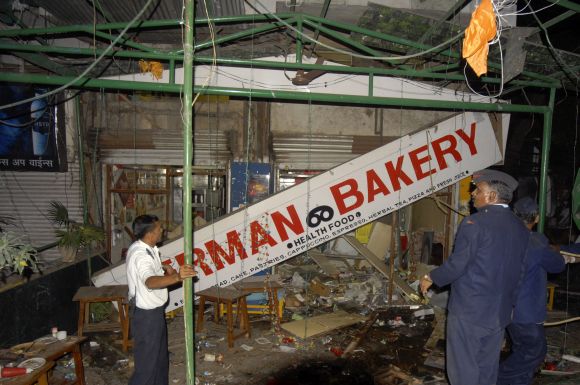 | « Back to article | Print this article |
Why Pune is so VULNERABLE to terrorism
In the light of Wednesday's four low-intensity blasts in Pune, there is a need for a co-ordinated revisit to reports being received from time to time since 2002 on the city being a major attraction for terrorist elements -- indigenous as well as foreign, notes B Raman.
Pune as a possible centre for jihadi activities first came to notice in March 2002, when Abu Zubaidah, the then No 3 to Osama bin Laden, was arrested by the Pakistani authorities acting at the instance of the USA's Federal Bureau of Investigation, in the house of an activist of the Lashkar-e-Tayiba at Faislabad in Pakistani Punjab and handed over to the FBI.
Zubaidah is now in the Guantanamo Bay Detention Centre in Cuba. Sections of the Pakistani media had reported at that time that Abu Zubaidah, a Palestinian, had studied computer science in Pune before crossing over into Pakistan and joining Al Qaeda.
Please click NEXT to read further...
Pune's long tryst with terror elements
In September-October, 2008, the Mumbai Police had arrested four IT-savvy members of the Indian Mujahideen, who had played a role in sending e-mail messages in the name of the IM before and after the Ahmedabad blasts of July 2008, and before the New Delhi blasts of September 2008, by hacking into Wi-Fi networks in Mumbai and Navi Mumbai. Three of them were from Pune. The four persons were:
Mohammed Mansoor Asgar Peerbhoy aka Munawar aka Mannu, a 31-year-old resident of Pune who was allegedly working for an American Internet company in its Indian office as a well-paid executive;
Mubin Kadar Shaikh, a 24-year-old graduate of computer science from Pu#8800
Asif Bashir Shaikh, a 22-year-old mechanical engineer from Pune. In addition to helping in sending the e-mail messages, he also reportedly played a role in planting 18 improvised explosive devices in Surat, all of which failed to explode; and
Mohammed Ismail Chaudhary, a 28-year-old computer mechanic, who was also suspected to have helped in planting the IEDs in Surat.
Peerbhoy was reported to have joined the IM while he was studying Arabic in Pune's Quran Foundation, which seemed to have served as a favourite recruiting ground for jihadi terrorism. (In this connection, reference is invited to my note 'India caught in cyber terror web').
Need for a co-ordinated assessment of Pune's vulnerability
Pune and its Chabad House figured prominently in reports on the visits to India by David Coleman Headley of the Chicago cell of the Lashkar-e-Tayiba, presently in jail in Chicago over his role in the 26/11 attacks in Mumbai.
Among the targets of interest to Headley in Pune were the local Chabad House, a Jewish cultural-cum-religious centre, which is frequented by Jewish visitors to Pune and the local Rajneesh Ashram frequented by the Western followers of Rajneesh, an Indian spiritual guru, who used to live in the US and was the mentor of some sections of Western youth.
Both these places reconnoitred by Headley were near the German Bakery, but neither of them was attacked on February 13, 2010. Instead, the German Bakery was targeted. The IM was reportedly involved in the explosion in the German Bakery.
Pune's educational institutions attract many foreign students from the Arab countries as well as Iran for studying computer science and other subjects. Since there were reportedly facilities for the study of Arabic in Pune, many Indian Muslims also go there.
One has the impression that the investigations made so far by the Maharashtra Police and its Anti-Terrorism Squad as well as by the National Investigation Agency into the activities of terrorism-prone elements in Pune after the arrest of some IT experts of the IM originating from Pune in 2008 have been disjointed focussing mainly on solving the instant cases without trying to see whether there were any linkages with other and past cases.
Now that Pune figures prominently in the terror map of India, it is important to make a co-ordinated assessment of Pune's vulnerability to terrorism of various kinds, including identification of pockets of possible Hindu extremism in the city.
TOP photo features of the week
Click on MORE to see another set of PHOTO features...



